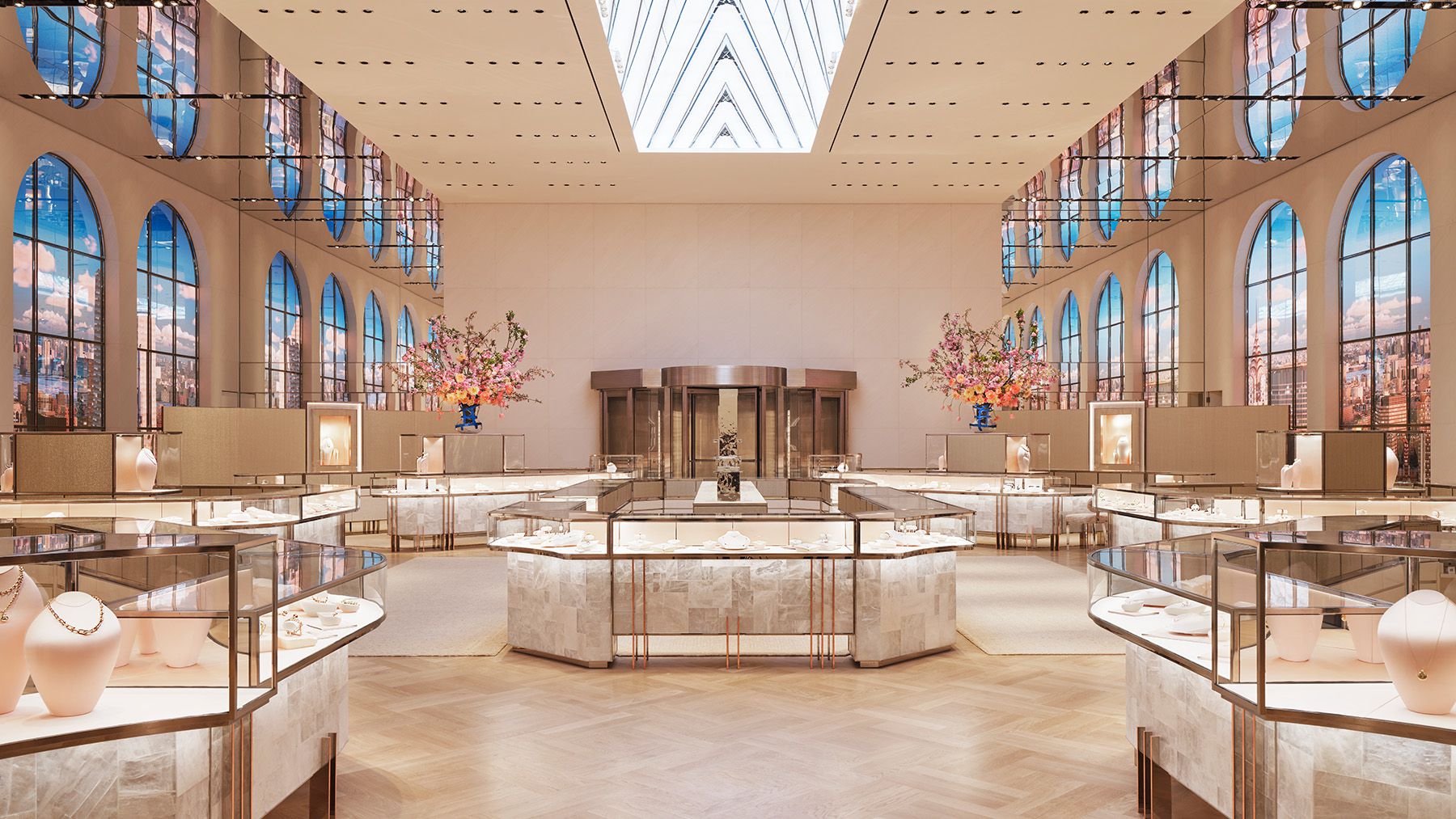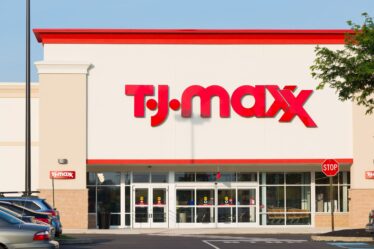
NEW YORK –– For luxury brands with global ambitions, a founding flagship is as important to the mission as Disney World is to Disney.
Nowhere is that more true than for Tiffany, which is set to reopen its Fifth Avenue flagship Friday after a multi-year renovation. In addition to being the most visible and famous manifestation of the brand (enshrined in the popular imagination by the 1961 film “Breakfast at Tiffany’s”), the store is a cash cow, generating around 10 percent of sales prior to its closure. Few, if any, luxury brands of Tiffany’s size rely so heavily on a single location.
For LVMH, which paid $15.8 billion (luxury’s biggest ever deal) to acquire Tiffany in January 2021, getting the renovation right is therefore critical to its “shock and awe” campaign to transform a beloved, if somewhat dusty name into a paragon of true luxury to rival the likes of Cartier and Bulgari. The store offers an unparalleled opportunity to define Tiffany for crowds of visitors from around the world who queue up outside its revolving doors — some 2 million are expected each year — and the millions more who view images from the store’s LED walls, salons, restaurant and exhibition space on social media.
Tiffany is just the latest example of how luxury brands are deploying heroic sums at brick-and-mortar retail. The new flagship, which LVMH dubs “Landmark,” steals the crown of luxury’s biggest single-brand store from corporate stablemate Dior, which unveiled a sweeping renovation of its Avenue Montaigne complex last year. Dior combined six buildings that belonged to the brand’s founder into a 10,000 square-meter complex with couture salons, a spa, rooftop gardens, a restaurant and pastry shop, and the world’s biggest fashion museum dedicated to a single designer.
Those two mega-stores follow efforts by other brands to create both lasting impressions and big revenues by scaling up: In 2018, Chanel renovated and expanded its founding Rue Cambon store behind the Paris Ritz, Gucci unveiled its “Garden” concept featuring an osteria and museum in Florence while Kering’s’ Boucheron showcased its archives of high-jewellery and photos of clients like Jane Birkin in a multi-level hub on Paris’ Place Vendôme. Other groups are likely to step up retail investments in a bid to keep up, like Prada, which is developing plans for bigger, higher-impact flagships under a new CEO.
Dior and Tiffany have pushed the trend to new heights, taking retail as the latest arena where luxury’s biggest group, LVMH, and the world’s wealthiest person, its chairman Bernard Arnault, can use their unrivalled financial firepower to expand their dominance of the sector. Eventually its biggest brand, Louis Vuitton, would probably like to have the group’s biggest store. A building LVMH recently acquired on the Champs-Elysées (the former headquarters of HSBC) could be a prime candidate, as could its Rue du Pont-Neuf headquarters.
“[LVMH] understand, I think, better than anyone, what it takes to enhance the experience of shopping, and that it’s not just transactional, that it’s really about education, and experience,” said Robert Burke, a retail consultant.
The Marino Touch
LVMH knows consumers need some reeducation when it comes to Tiffany. Pre-acquisition, the brand was too closely associated with engagement rings and sterling silver, with a somewhat preppy, bourgeois image that couldn’t match European rivals like Cartier in courting wealthier global customers who spend anywhere from a tens of thousands to a few million euros on a single shopping trip.
Which is one reason why the luxury conglomerate reportedly spent a record amount on the renovation, overseen by Peter Marino, the go-to architect for luxury’s recent mega-projects, including Dior’s Avenue Montaigne hub, Chanel Rue Cambon and the Cheval Blanc hotel inside La Samaritaine department store.
Elements of those projects and others were incorporated at Tiffany — reflecting its unprecedented scale, and central role in the brand’s narrative.
Light-filled, airy spaces oriented around a dramatic staircase are a Marino signature, most notably in Dior Montaigne — where a central atrium allows visitors’ eye to graze over various departments including a trendy bistro and nooks for homewares and jewellery before filtering off into the store’s more private selling spaces.
At Tiffany, a central staircase designed to evoke the curves of an Elsa Peretti design invites visitors to explore from the third floor all the way up to eighth.
“It’s not a building that is made of slices of floors put on top of each other, but it is an actual volume, and [visitors] are allowed to circulate within the volume,” said Thomaï Serdari, professor of marketing and director of the fashion and luxury MBA program at NYU’s Stern School of Business.
The wood panels that lined Tiffany’s ground floor have been replaced with wall-to-wall LED screens depicting Central Park. Though far larger, the digital landscape will ring familiar to anyone who’s taken a dip in the Cheval Blanc hotel’s indoor pool, which also features an LED wall, in that case rendering a virtual view of the river Seine.
At Tiffany, LVMH put all the pieces of a modern luxury megastore together, only bigger, and in America, which has fewer heritage brands to call its own.
“All of [LVMH and Marino’s] different projects have kind of led up to this,” Burke said.
Reinforcing Codes
Just like Disney World is peppered with “hidden Mickeys” — mouse ear silhouettes that are worked into everything from wrought iron fences and mosaics to manhole covers — the new class of luxury flagships are layered with references to brand “codes,” the vocabulary of signatures that designers are charged with reinterpreting and celebrating year after year.
Tiffany’s “hidden Mickey” is arguably its bird motif, harkening back to designer Jean Schlumberger’s “Bird on a Rock,” a diamond-encrusted fowl perched on an impressively large precious stone first sold in 1965. A tourist who only knows Tiffany for Audrey Hepburn and robin’s egg blue (or now, maybe, Beyonce) might not know why it’s an animated bird swooping down through the giant LED screens, or why vaguely tropical birds ended up on the New York-themed bone china mugs in the Lauren Santo Domingo-curated homewares department a few floors up.
But brand devotees will appreciate the nods. A customer lucky (and wealthy) enough to be ushered into the private dining room in the 10th floor’s VIP-only shopping suite may even clock the bejewelled cockatoo nestled in a corner of one wall, which depicts the gardens of Marino’s Southampton estate.
Similar tactics were deployed at Dior. It’s bathed in the brand’s trademark purplish shade of grey, and its decor features countless references to its founder’s favoured flowers and nipped-waist silhouettes. Iron tables in the café are rendered in a cannage pattern most famously (and profitably) seen on the Lady Dior bag that has been the biggest driver of sales since the 1990s.
Balancing History and Modernity
A digital, animated rendering of a nearly 60-year-old piece of jewellery isn’t the only way Tiffany is trying to make strategic use of its past.
The Tiffany flagship, which opened in 1940, owes much of its aura to Audrey Hepburn, who in “Breakfast at Tiffany’s” looked into the same windows shoppers will line up outside of on Friday. And it’s where many millions of shoppers have passed through the revolving doors. That sort of history is rare in American retail, and priceless for a luxury brand.
“Places are very important for brands, they are a part of the brand’s history and myth,” said Delphine Dion, LVMH chaired professor of marketing and luxury brand management at ESSEC Business School in Paris. “If you go to Chanel on Rue Cambon it is not a regular store … it’s a store where Coco Chanel used to work. This is where she used to live. You have this aura.”
LVMH’s task, then, was to remind visitors of the history without smothering them with it (and keeping in mind that Breakfast at Tiffany’s may not resonate quite as strongly with the next generation of jewellery consumers).
“It’s not about a museum of the past, it’s a complete reinterpretation of the brand through architecture,” Dion said.
Art plays a role in bridging the past, present and future too. The recent alignment with art by luxury megabrands — also seen at Prada’s cutting-edge Fondazione in Milan, or Louis Vuitton’s blockbuster activations to promote its collaboration with Yayoi Kusama — are a savvy way to position themselves as brokers of culture, and to create a halo around their products.
Tiffany’s flagship is stocked with about 40 works, many wall-sized and brightly coloured, from names like Jean-Michel Basquiat and Julian Schnabel who will be well-known to even casual fans of modern art.
Each piece is key to evoke history while adhering to the current brand expression. Basquiat’s “Equals Pi” painting, which has a prominent place on the ground floor, is a prestigious way to say “New York,” while also reminding visitors of the brand’s first campaign after signing Beyoncé and Jay-Z as ambassadors (the yellow Tiffany diamond, perhaps the brand’s best-known piece and that also featured in the ads, is on display nearby).
“It’s a way to show the preciousness of the [jewellery] pieces, to show that they are very unique, they are like art pieces,” Dion said. “They are not normal goods, not mass market goods, they are goods that are super unique exactly as art.”
Hiding the Family Silver
The most overt nod to nostalgia is without a doubt the “Audrey Hepburn Experience” on the fifth floor, a room that allows superfans to surround themselves with videos and photos of the actress in her signature black dress while staring at a replica of the famous Givenchy garment.
Not coincidentally, the floor is also where visitors will find Tiffany’s fragrances, wallets and other relatively affordable crowd pleasers. That also includes the silver collection, a major sales driver that LVMH has de-emphasised compared to more-expensive gold jewellery, which can be found one floor down (engagement rings claim the prime third floor at the base of the staircase).
LVMH has been clear from the start that it wants to attract a wealthier customer. For that it has two main avenues of attack: the first is more offerings in the fine jewellery category, including the “lock” bangles that launched last year, a collection of gold bracelets ranging in price from $7,000 to $36,000.
In addition to their higher price tag, the bangles are intended as a more-contemporary twist on Cartier’s “Love” bracelets. It has served, along with the Beyonce campaign, the Cryptopunks NFT release and the recent Nike collaboration, as an effort to connect with consumers without having to evoke the ghost of Audrey.
“Lock has been a success and is supporting the ‘design jewellery’ business, a core pillar of any jewellery brand,” wrote Bernstein analyst Luca Solca in an email. “Tiffany has also rejuvenated its marketing approach, moving it to the modern times – more digital, more celebrities, less motherhood and apple pie.”
The elevation campaign includes the VIP suite accessible only by a private elevator for qualifying customers (the criteria for access isn’t something Tiffany talks about; “spend” is as good an answer as you’ll get about how to get in). A full bar greets guests, who might then wander into the library stocked with century-plus-old Tiffany “blue book” catalogs, or various sitting areas.
There, commerce occurs against a backdrop of epic views of Central Park and Midtown Manhattan — the real thing, no LED screens necessary.
Robert Williams contributed to this article.
Disclosure: LVMH is part of a group of investors who, together, hold a minority interest in The Business of Fashion. All investors have signed shareholders’ documentation guaranteeing BoF’s complete editorial independence.



